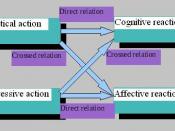Table of Contents
1.0 Introduction p. 2
2.0 How can culture be defined p. 2
2.1 Breaking down definition of culture p. 2
2.1.1 The outer layer p. 3
2.1.2 The middle layer p. 3
2.1.3 The core p. 3
3.0 Individualism and Collectivism p. 4
3.1 Individualism p. 4
3.1 Collectivism p. 5
4.0 The effect on the core layer of culture - Individualism and Collectivism
- on the conduct of business p. 5
4.1 The effect on strategy for interpersonal relationships p. 6
4.2 The effect on award achievements p. 6
4.2 The effect of making decision p. 7
5.0 Conclusion p. 8
6.0 Bibliography p. 9
1.0 Introduction
As the globalization invades our daily business in present times, people activities starts to become interrelated across boundaries. Different people might have different backgrounds and culture affects a person's behaviors. Culture is the invisible backbones to our societal body.
Because of globalization, intercontinental negotiation between business leads to cultural conflicts, for instance, mistrust between partners. The cultural divide might have assorted impacts on conduct business. In this report will firstly define culture and then investigate how invisible culture affects business behaviors on conduct business.
2.0 How can culture be defined?
Culture is intangible in shape; however it is essential for each one of us. Culture builds up of a particular society's behaviors, from religion beliefs to dressing style to art to methods of farming. Trompenaars and Hampden-Turner (1997, p.3) consider that culture is a shared belief of a group of people and is made up of three layers. Understanding culture constituents might help in visualizes the effects on conduct business.
2.1Breaking down definition of culture
Culture can be found in 3 major levels: the outer layer, middle layer and core. The different layers are complementary. (Trompenaars and Hampden-Turner,


